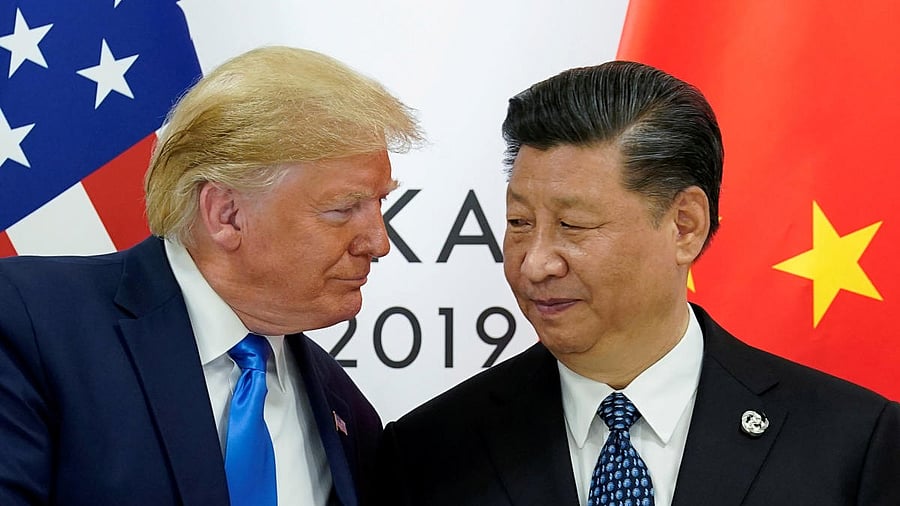
US President Donald Trump with China's President Xi Jinping.
Credit: Reuters File Photo
Colombia’s run-in with Donald Trump is a warning to other countries trying to decipher the US president’s haphazard decision-making process. As Asian nations realize that Trump’s second term could be even more erratic than his first, China is ready to take advantage of the chaos.
Trump’s latest move to impose 25 per cent tariffs on an ally for not complying with his deportation demands should serve as a wake-up call. Even though the levies were quickly reversed, he achieved what he presumably set out to do: Show the world who’s boss.
“This reminds governments that this is a president that behaves on a whim,” Deborah Elms, head of trade policy at the Hinrich Foundation in Singapore, told me. “You never would have imagined before that the US would impose immediate harsh penalties on a really important ally, in a really important region. If you can do it to Colombia, you can do that to anyone.”
China will take every opportunity to step in. Beijing was already cozying up to Bogotá before the spat with Washington, but has been accused of exploiting the situation further. Zhu Jingyang, China’s ambassador to Colombia, told the local newspaper El Tiempo that relations between the Asian and Latin American countries were “at the best moment” since establishing diplomatic ties 45 years ago, adding they “are global cultural powers.” He went even further, saying that their differences, “far from creating obstacles, bring us closer and enrich us.”
Losing a key US ally to China’s influence is a reckless move at best, foolish at worst. Historical ties to Washington have meant that Colombia has in the past approached Beijing with a greater degree of caution than many of its neighbors. South American, North American, and European companies have typically won contracts and gained market access over Chinese ones, with some exceptions.
So when Colombian President Gustavo Petro visited Beijing in 2023, elevating ties to a strategic partnership, observers saw it as a notable win for China, and part of the nation’s greater economic engagement with the region. China’s trade with Latin America — including imports of raw materials and food supplies, and exports of manufactured goods — grew to over $450 billion in 2022 from around $18 billion in 2002. The closer ties with Beijing coincided with a perceived rift between Bogotá and Washington over issues critical to the relationship, such as counter-narcotics, peace, and security.
For Asian nations, Colombia’s experience is a chilling reminder that they better get their Trump 2.0 plans in order. It’s hard to predict which countries are most at risk, but one good gauge might be to look at who has a trade imbalance with the US.
China is the most high-profile country at risk. Trump began his targeting of Beijing for unfair-trade-related issues in his first term, and slapped tariffs on the world’s second-largest economy. The stance is a central plank of his engagement with trade partners, and he announced that he’s mulling a 10 per cent tariff on Chinese imports, potentially set to take effect Feb. 1. Recently though the US president talked about using them as a last resort, a move that suggests yet again, anything can be traded to make a bargain.
Still, a 10 per cent tariff carries heavy consequences for Beijing. Bloomberg Economics estimates that it could knock out 40 per cent of China’s goods exports to the US, putting 0.9 per cent of gross domestic product at risk. Beijing would likely retaliate with duties of its own, ensuring that the world’s two superpowers end up in a protracted trade battle.
Outside of China, tariff risks are highest for Vietnam, Japan and South Korea. Priyanka Kishore notes in her Asia Decoded Substack that each reported more than a $40 billion trade surplus with the US in 2023. The entire region could be in the firing line, except perhaps tiny Singapore, which has an overall trade deficit with the US. Even so, certain sectors could be at risk — the city-state recorded a close to $9 billion trade surplus with the US in pharmaceutical products in 2023, Kishore writes.
Southeast Asian nations, in particular, have long resisted the narrative of having to choose between the US and China, as the former Singapore Prime Minister Lee Hsien Loong told me in an interview in 2021. “I hope the time does not come,” he said.
Governments in the region should think about what they can offer Trump if they end up attracting his attention. Capitulating the way that Colombia did may not be an option. But Washington should also be wary that in the strategic competition between China and the US, the superpower that isn’t pointing a gun at a partner’s head may be more appealing as an ally in the future.
The US’s allure over China is that it has always been able to offer a stable, reliable business and policymaking environment, one that could be depended on to follow the rule of law. Under Trump, that’s not so certain anymore.